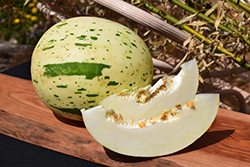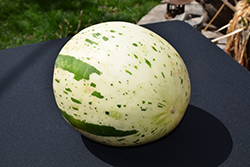Fri & Sat 8am - 8pm
Sun 8am - 7pm
Anytown, USA 12345
fax: 261.787.0463
e-mail: info@successgc.com


Plant Finder

Ivory Gaya Melon
Cucumis melo var. inodorus 'Ivory Gaya'
Height: 18 inches
Spacing: 3 feet
Sunlight:
![]()
Hardiness Zone: (annual)
Other Names: Snow Leopard Melon, Ghost Melon, Snowball Melon
Description:
A compact variety that features unique and interesting melons; small, round to oblong fruit showcase thin, smooth ivory skin with green speckles and streaks; creamy white dense flesh is mild and sweet, great for a number of culinary applications
Edible Qualities
Ivory Gaya Melon is an annual vegetable plant that is commonly grown for its edible qualities. It produces small creamy white round melons (which are technically 'berries') with green variegation and creamy white flesh which are typically harvested when mature. The melons have a mild taste and a pleasant fragrance.
The melons are most often used in the following ways:
- Fresh Eating
- Eating When Cooked/Prepared
- Freezing
Planting & Growing
Ivory Gaya Melon will grow to be about 18 inches tall at maturity, with a spread of 4 feet. When planted in rows, individual plants should be spaced approximately 3 feet apart. This vegetable plant is an annual, which means that it will grow for one season in your garden and then die after producing a crop.
This plant is typically grown in a designated vegetable garden. It should only be grown in full sunlight. It does best in average to evenly moist conditions, but will not tolerate standing water. This plant is a heavy feeder that requires frequent fertilizing throughout the growing season to perform at its best. It is not particular as to soil type or pH. It is somewhat tolerant of urban pollution. Consider applying a thick mulch around the root zone over the growing season to conserve soil moisture. This is a selected variety of a species not originally from North America.

